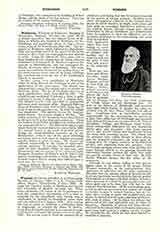

Wilmington, Diocese of (WILMINGTONIENSIS), erected March 3, 1868. It includes what is known as the Delmarvia Peninsula, the State of Delaware, nine counties of Maryland, and two counties of Virginia east of Chesapeake Bay. The first Catholic mission in this territory was founded at Bohemia Manor, Cecil Co., Maryland, in 1704 by the Jesuits, who were the only priests on the peninsula until 1808, when Rev. Patrick Kenny came to reside at Coffee Run, Delaware (see Delaware). The first church in the city of Wilmington was St. Peter’s (1808), now the cathedral. The first bishop was Rt. Rev. Thomas Andrew Becker (q.v.), before his election a priest at Richmond, Virginia. He found in the new diocese only eight priests and fourteen churches, most of these scarcely more than sheds. St. Peter’s Orphanage and St. Peter’s School were in charge of the Sisters of Charity, two more schools had recently been closed, and the sisters withdrawn to Philadelphia. The Catholic population of the whole diocese did not exceed 5000. By constant and untiring effort in the face of extreme poverty, scarcity of vocations, and many other difficulties, Bishop Becker increased the number of churches to twenty-six and the clergy to twenty-one. He brought to the diocese the Benedictine Fathers, the Sisters of St. Francis (Glen Riddle, Pa.), and the Sisters of the Visitation. He also founded an orphan asylum for boys. During his episcopate the Catholic population increased to about 18,000.
In 1886 Bishop Becker was transferred to Savannah, Georgia, and was succeeded by Rev. Alfred A. Curtis, at that time chancellor of the Archdiocese of Baltimore. Bishop Curtis was born on July 4, 1831, in Somerset Co., Maryland, and was therefore a native of the diocese. He was reared as an Episcopalian, and was ordained to the ministry of that church. As such he was stationed a short time at Chestertown, Kent Co., Maryland, in his future diocese. In 1872 he visited England, where he was received into the Church by Cardinal Newman. Returning he entered St. Mary’s Seminary, Baltimore, where he was ordained by Archbishop Bayley, December 19, 1874. He was consecrated Bishop of Wilmington on November 14, 1886. To pay off numerous debts contracted in the rapid extension of the diocese by his predecessor and to provide laborers and means to continue the work was a task that called for unusual zeal and energy. Yet so well did he fulfill it that in the ten years of his episcopate the number of churches was increased by thirteen and the clergy by eight. He established a mission for colored people, placing the Josephite Fathers in charge. He also brought to the diocese the Benedictine and the Ursuline Sisters. One of his chief works is the Visitation Monastery, which he built and had endowed in order that the sisters might become exclusively contemplative according to the primitive rule of their order. He died on July 14, 1908, and, at his own request his remains were buried within the enclosure of this monastery. In 1896 Bishop Curtis resigned, leaving the diocese with 39 churches served by 29 priests, and with four communities of teaching sisters, 1 contemplative community, 3 orphanages, an industrial school, and a Catholic population of 25,000.
The third and present bishop is the Rt. Rev. John J. Monaghan. He was born May 23, 1856, at Sumter, South Carolina, and educated at St. Charles College, Ellicott City, Maryland, and St. Mary’s Seminary, Baltimore. He was ordained on December 19, 1880, and served at various posts in the Diocese of Charleston until his appointment as bishop. He was consecrated at St. Peter’s Pro-Cathedral on May 9, 1897. Under his administration the growth of the diocese has continued. Among the most notable of his acts are the introduction of the Oblate Fathers of St. Francis de Sales (1903) and of the Little Sisters of the Poor (1903). The former conduct a day college for boys, while the latter care for the aged poor. The churches already in existence have been remodeled, new buildings provided for the orphans, four new churches added in the country and two in the city, a residence for the bishop was purchased, and all placed on a prosperous footing during this administration. The growth of the diocese continues, not with the strides of those dioceses where immigration is large, but, if slowly, yet surely. Over eighty per cent of the Catholic population is in Wilmington and its neighborhood. The foreign elements are found here almost exclusively. The parochial schools, with a single exception, are in or around the city. The remainder of the diocese is still a missionary district, the Catholics are few and scattered, and some churches are visited only once a month. In the whole diocese the Catholics form legs than nine per cent of the population.
Statistics (1911): diocesan priests 38; religious 18; churches with resident priests 27; mission churches 21; chapels 5; stations 14; academies 2; college 1; parochial schools 13, with 3900 pupils; orphan asylums 256; industrial school for colored boys 1, with 60 inmates; religious communities of men 3; communities of women 7; Catholic population 35,000.
JAMES L. MCSWEENY

